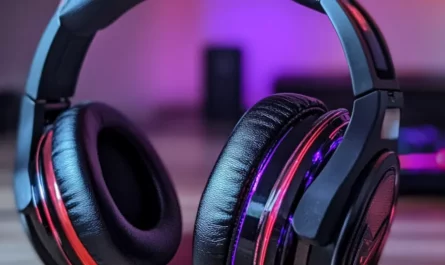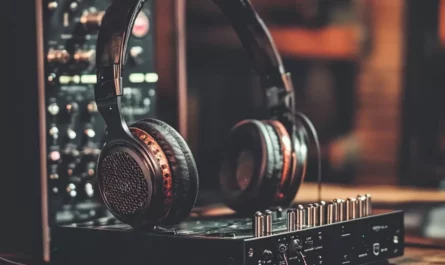Wooden headphones have become a symbol of craftsmanship and premium audio quality in recent years. While most consumers are familiar with the traditional materials used in headphone manufacturing, such as plastic, aluminum, and synthetic composites, the allure of exotic woods has captured the attention of audiophiles and designers alike. These wooden headphones, often handmade, are praised for their natural resonance and the unique aesthetics they bring to the listening experience.
But beyond their beauty, an essential question arises: Do exotic materials like wood actually affect sound quality? This article takes a scientific approach to explore whether the choice of exotic wood in headphone design goes beyond mere appearance and contributes to a measurable improvement in sound. We’ll break down the physics behind sound, examine different wood types, and analyze empirical evidence from controlled sound tests.
Why Wood? Understanding the Material’s Acoustic Properties
At the core of this discussion is the material itself. Why choose wood? While synthetic materials are easy to mass-produce and manipulate, wood offers an organic structure that responds to sound waves in unique ways. But what exactly makes wood such an attractive choice for acoustic design?
Wood, being a natural material, has inherent vibrational properties that are closely related to its density and grain structure. These properties affect how sound waves travel through the headphone casing, influencing factors like resonance, dampening, and frequency response. Unlike plastic, which can create a sterile or flat sound, wood introduces harmonic warmth, making the sound feel richer and more immersive.
- Natural resonance: Wood’s ability to resonate in harmony with sound waves can enhance certain frequencies, providing a fuller sound experience.
- Dampening capabilities: Due to its organic structure, wood can absorb excess vibrations that would otherwise distort sound, contributing to a clearer output.
However, these benefits vary widely depending on the type of wood used, which brings us to the next section.
Types of Exotic Woods Used in Headphones
The allure of exotic woods isn’t just about their looks—each type of wood offers different acoustic properties that can alter the sound profile of headphones. From high-density hardwoods to more porous varieties, the choice of wood affects how the headphones will respond to different frequencies.
Here are some of the most popular exotic woods used in headphone design:
- Mahogany: Known for its balanced tone, mahogany is a dense hardwood that offers excellent dampening properties. It enhances midrange frequencies and is commonly used in high-end acoustic instruments for its ability to produce a rich, warm sound.
- Ebony: This extremely dense wood has a bright tonal quality, often favored for its ability to produce clear, crisp highs without sacrificing the fullness of the lower frequencies.
- Rosewood: Favored for its visually striking grain, rosewood provides enhanced bass response and deep resonance, making it ideal for headphones that focus on low-end frequencies.
Each of these woods has its own strengths, and headphone manufacturers carefully select materials based on the sound profile they want to achieve. The density, grain structure, and moisture content of these woods all play a role in how the headphones will ultimately sound.
Scientific Methods for Measuring Sound Quality
To understand the impact of exotic wood on sound quality, we must rely on objective measurements of audio performance. Audiophiles often speak subjectively about the warmth or brightness of wooden headphones, but it’s crucial to analyze these claims using controlled experiments.
There are several standard scientific methods used to measure sound quality:
- Frequency Response Testing: This method measures how accurately a pair of headphones reproduces different frequencies (from bass to treble). A flat response is ideal, meaning the headphones can reproduce all frequencies equally, but many woods are chosen for how they enhance or suppress certain ranges.
- Harmonic Distortion Measurement: Wood’s dampening properties can reduce harmonic distortion, meaning the sound remains clearer and less “muddy” at higher volumes.
- Impulse Response Testing: This technique evaluates how quickly and accurately the headphones can reproduce sound changes. Woods like mahogany and rosewood tend to offer faster decay rates, meaning the sound fades naturally without harshness.
These tests provide concrete data that help manufacturers fine-tune their designs, balancing aesthetic choices with acoustic performance. While the choice of wood can influence the results, it’s important to note that the overall construction and driver technology also play a significant role.
The Role of Wood Density in Sound Transmission
Wood density plays a crucial role in how sound waves interact with the material, directly influencing the acoustic properties of headphones. In the world of headphone design, density refers to how compact the wood fibers are, which impacts both the resonance and the dampening of sound. Higher-density woods tend to transmit sound waves more effectively, while lower-density woods may absorb more of the sound, creating a warmer and softer tone.
A key point to understand is that the transmission of sound through a material is a complex interplay between stiffness and mass. Dense woods like ebony and rosewood, for example, are highly effective at transferring sound energy without losing much in the way of fidelity. This is because they minimize internal vibration, allowing the headphones to maintain clarity across all frequency ranges.
However, low-density woods also have their advantages, particularly when it comes to dampening unwanted vibrations. A softer wood like maple or walnut may offer a warmer and more intimate sound, as these materials absorb higher-frequency vibrations that can sometimes lead to harshness or distortion.
In terms of density:
- High-density woods (such as ebony) provide sharper, more defined sound with a focus on the treble range.
- Low-density woods (such as maple) contribute to a richer, warmer tone, often enhancing the bass and midrange.
Impact on Bass, Mid, and Treble Frequencies
The material of the headphone casing can have a profound impact on how different frequency ranges are perceived by the listener. While the drivers inside the headphones generate the sound, the casing, especially when made of wood, can shape how these sound waves are delivered to the ear.
The effects of exotic woods on bass, mid, and treble frequencies vary based on the type of wood used, its density, and the overall design of the headphones. Each frequency range responds differently to the wood, contributing to the overall sound signature of the headphones.
Bass Frequencies
Bass, or low-frequency sounds, are often the most impacted by the use of wood. Exotic woods, particularly those that are denser, tend to enhance the depth and clarity of bass tones. This is because dense woods can handle the vibrational energy of low-frequency sounds without distortion. For example, rosewood is often praised for its ability to produce deep, powerful bass that doesn’t muddy the mids or highs.
- Rosewood and mahogany: Offer full-bodied, rich bass tones with excellent depth.
- Maple and walnut: Provide a softer, rounder bass experience that complements vocals and midrange frequencies.
Mid Frequencies
The midrange is where vocals and most instruments live, making it an essential part of the audio spectrum for clarity and detail. Wood types that offer balanced dampening properties, like mahogany and ebony, tend to excel in the midrange. These woods ensure that the mid frequencies are clear and distinct, without becoming overwhelmed by the bass or treble.
- Mahogany: Known for its ability to deliver balanced mids, ideal for vocals and acoustic instruments.
- Ebony: Offers a crisper, more defined midrange with an emphasis on clarity and detail.
Treble Frequencies
High-frequency sounds, or treble, are more susceptible to becoming harsh or brittle if not properly managed. Exotic woods, particularly those with lower density, can help soften these high frequencies, producing a more natural and pleasant listening experience. However, very dense woods like ebony can emphasize treble, giving the sound a sharp, bright quality.
- Ebony: Enhances treble clarity, making the sound more vibrant and detailed.
- Maple: Softens high frequencies, reducing any potential harshness or sibilance.
Subjective vs. Objective Listening Experience
One of the most intriguing aspects of wooden headphones is the balance between objective sound quality—what can be measured scientifically—and the subjective experience of the listener. While it’s easy to measure things like frequency response, total harmonic distortion, and resonance, the perception of sound is highly individual. This is where exotic materials, like wood, come into play.
From a subjective perspective, many audiophiles report that wooden headphones create a more immersive and warm sound experience compared to plastic or metal casings. This is often attributed to the natural acoustic properties of wood, which tend to produce a more organic and pleasing tonal quality. Some listeners also describe the sound as more “musical” or “natural,” especially when listening to genres like jazz, classical, or acoustic music.
However, objective testing tells a slightly different story. While wood can enhance certain frequencies and provide better resonance, the overall impact on sound quality is often subtle when compared to other design elements like driver technology or ear pad materials. Empirical measurements often show that wood can improve sound dampening and reduce distortion, but the differences are not always as significant as subjective listeners may perceive.
In conclusion, while wooden headphones can provide a unique and pleasant listening experience, much of the perceived improvement is tied to personal preference and the type of music being played. The emotional connection to natural materials and craftsmanship can also influence how we hear and interpret sound.
Comparing Wood to Other Materials: A Benchmark
To fully understand the role that exotic wood plays in headphone design, it’s helpful to compare it with other commonly used materials. Headphones made from plastic, aluminum, or composite materials are far more common and serve as a useful benchmark for evaluating the impact of wood.
Plastic, the most widely used material, is prized for its lightweight nature and ease of manufacturing. However, plastic does not offer the same resonance control as wood, often leading to a flatter, less dynamic sound. On the other hand, metal materials like aluminum provide durability and can offer a more precise sound signature due to their rigidity, but this can sometimes lead to a colder, less organic sound.
Let’s break down the comparison:
- Plastic: Lightweight, affordable, but often lacking in acoustic warmth.
- Metal (e.g., aluminum): Provides more durability and precision, but can sound colder and less immersive.
- Composite materials: Offer a balance of properties but lack the natural warmth and aesthetic appeal of wood.
When benchmarked against these materials, wood stands out primarily for its ability to naturally enhance bass and midrange frequencies while offering a unique listening experience. However, it’s important to remember that the drivers and overall design of the headphones play a significant role in sound quality as well. The material of the casing, while influential, is just one part of the equation.
Questions and Answers
Wood can enhance certain frequencies, particularly in the bass and midrange, but the overall improvement depends on factors like wood type, headphone design, and listener preference.
Wooden headphones are often chosen for their aesthetic appeal and the natural warmth they can bring to the sound, which is especially appreciated by audiophiles for more organic listening experiences.
Rosewood and mahogany are commonly favored for their ability to produce deep, rich bass without distorting other frequencies.



